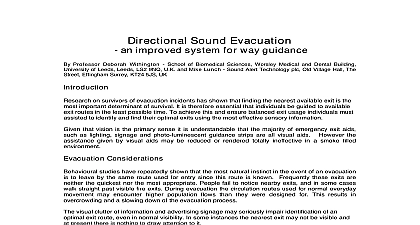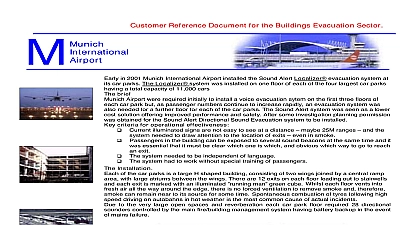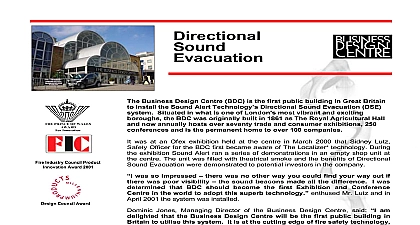System Sensor Directional Sound Life Saving App

File Preview
Click below to download for free
Click below to download for free
File Data
| Name | system-sensor-directional-sound-life-saving-app-2807963415.pdf |
|---|---|
| Type | |
| Size | 711.68 KB |
| Downloads |
Text Preview
Life Saving Applications of Directional Sound D Withington School of Biomedical Sciences Worsley Medical and Dental Building of Leeds Leeds LS2 9NQ U K and Sound Alert Technology plc 175 Woodhouse Leeds LS2 3AR U K Withington is a Professor of Auditory Neuroscience at Leeds University UK Her chair awarded for excellence in Research and Innovation Her research over 20 years has directional sound and human responses to sound She moved from the National of Medical Research London UK to Leeds University in 1990 After initial sponsorship the Medical Research Council she was made a Senior Medical Research Council Fellow in In the last 8 years her attention has focused on life saving applications of directional particularly its role in evacuations She has published many research articles and book on directional sound in real world use She has spoken at many international in the year 2001 these included the NFPA the International Symposium on Aviation and the International Fire and Cabin Safety Conference In 1994 she co founded Alert Ltd as a University Spinout Company based on the patented technology of Sound In 1997 Sound Alert was given the prestigious Prince of Wales Award for University of Leeds is among the top ten research universities in the UK It has some 3,000 including postgraduates The variety of research activity extends across all faculties departments often crossing traditional subject boundaries Interdisciplinary research is through some 58 home departments and some 58 research centers and institutes ranging from small local companies to major multinationals benefit from collaboration Leeds researchers Issue the scenario of a smoke filled building The fire alarm is ringing telling you to leave The most important question facing you is Where do I go to find a safe exit most buildings exit routes are identified by visual means exit signage All signage is obscured with even low levels of smoke Exits can also be hard to find in visually areas such as an airport or shopping mall An obvious solution is the use of sound since hear perfectly well even in smoke If sound is utilized to identify exits then it is vital that can instantly pinpoint where the sound is coming from in other words directional sound be directional the sound must be broadband2 in composition containing the majority of from the human hearing range of the most frightening experiences is to be lost and disoriented Being truly disoriented may relatively rare but it may happen to any of us at any time As a newcomer to an unfamiliar you will most likely experience some degree of stress or anxiety that progressively as your disorientation increases As time passes however by looking at signs asking for directions and exploring your environment you are able to move through it efficiently of us however is totally familiar with all environments Many behavioral studies have shown that one of the most natural instincts in the event of a fire is people evacuate a by the route through which they entered This is rarely the quickest or most appropriate Many people fail to spot nearby exits and in some cases walk straight past visible fire exits repercussions of such actions have been severe that vision is our primary mode of perceiving our environment 83 of what is learned is the eyes it is not surprising that the majority of emergency egress aids such as lighting signage color coding walls and doors and photoluminescent guidance strips solely visual based effective are such aids when the part of the building you are in is completely or partially filled smoke or if you are visually impaired Sources as Way Finding Aids is clear that this reliance upon visual means just isn good enough in modern evacuation It is imperative that another sensory method is activated therefore the use of sound the obvious solution At Leeds University such a way finding aid has been researched developed by Deborah Withington Professor of Auditory Neuroscience with extensive field showing it to offer fast efficient evacuation for sighted visual and learning impaired users Sensor has incorporated this new egress technology researched by Leeds University into Sound units3 This is a broadband multi frequency sound The sound source is easily quickly located by our ears making it ideal for rapid evacuation applications Triggered by fire detection systems Directional Sound positioned at carefully chosen locations guide along escape routes They can also guide people up or down stairs all uses of sound in an emergency evacuation are provided in the form of an alerts people to the presence of imminent danger General evacuation alarms give no concerning the direction to or location of the nearest exits Even if the current alarm devices were placed over exit doors they would still be impossible to locate these types of sounders are not directional To understand why the current devices would suffice as exit locators it is necessary to describe how we manage to locate sounds superior colliculus9 SC part of the mid brain plays a vital role in the detecting of as well as to a sound source Neurophysiologists studying the properties of neurones in the SC with psychoacousticians8 studying human responses to sound have enabled us to how the brain processes information relating to a sound source It has long been that localizing a sound source requires a vast amount of neural processing Only types of sounds are inherently directionally identifiable What is crucial is that they contain large spectrum of frequencies that is broadband noise Pure tones simple tone combinations of noise cannot be localized hear a vast range of frequencies from approximately 20Hz to 20,000Hz Hz Hertz There three main types of information that allow the brain to directionalize sound The first two are as binaural1 cues because they make use of the fact that we have two ears separated by width of our head A sound that emanates from either side of the mid line will arrive first at the closest to it and will be loudest at the ear closest to it At low frequencies the brain recognizes in the arrival time of sound between the ears interaural time differences6 and at frequencies the salient signal is the loudness intensity difference between the sound at each interaural intensity differences5 Figure 1 single frequencies these cues are however spatially ambiguous The inherent ambiguity has described as the of confusion This arises from the fact that for any given frequency are numerous spatial positions that generate identical timing intensity differences These can graphically represented in the form of a cone the apex of which is at the level of the external The cone of confusion is the main reason for our not being able to localize pure tones Figure 1 The localization cues of interaural time and intensity differences 2 Examples of frequency dependent attenuation for sources in front above and a listener final piece of sound localization information processed by the brain is the head related transfer HRTF The HRTF refers to the effect the external ear has on sound As a result of over the bumps or convolutions of the pinna7 the sound is modified so that some are attenuated and others are amplified Figure 2 Although there are certain in the way the pinna modify sound the HRTF is unique to each individual The role of HRTF is particularly important when determining whether a sound is in front of or behind us In instance the timing and intensity differences are negligible and there is consequently very little available to the central nervous system on which to base this decision To locate the of a sound source the larger the frequency content to overcome the ambiguities inherent single tones the better the accuracy Sound and Evacuation Tests are many examples of applications where Directional Sound dramatically improves safety of the most important is in evacuation guidance Directional Sound has applications in and other situations where emergency egress lighting is currently positioned The signals be used to locate exit points and for guidance in complex evacuation routes such as from a core


